OUR MADAGASCAR
MORE than just an island
It has been described as the eighth continent, a world apart, evolution’s playground, or the “Galapagos of the African Continent”.
The fourth biggest island in the world holds a rich mixture of 18 cultures, an astounding variety of landscapes and amazing fauna and flora.
According to a lot of travellers who discovered this unique island „Madagascar is unlike anywhere I have been to – fantastically beautiful, amazingly diverse for its size (similar to France) and still so unspoiled. Vast tracts of the country are virtually uninhabited and seldom explored…” (Emilie Filou, writer, Lonely Planet Guides)
It is one of the best water sport destinations with untouched beaches, blue sparkling water, colourful coral reefs and small-personalised resorts. If you want to enjoy the beach and sun or rather want to fish, dive, surf or sail, Madagascar is the place to visit.
The fauna on the island differs from that of Africa: the world’s biggest butterfly is found on the island, as well as the world’s smallest and biggest chameleon, tortoises and a variety of bird species. More than a hundred types of lemur – not a single one found anywhere outside Madagascar – so diverse that some bounce across the ground like kangaroos and some howl their eerie ‘whalesong’ from the treetops, while others winkle grubs from beneath tree bark with their bony, knitting-needle fingers.
There are incredible deserted beaches, world-class dive sites, opportunities for all types of other watersports from windsurfing to kite-surfing, delicious cuisine, yacht charters, treks through startling landscapes, not to mention the warm welcome you will receive from the ever-smiling Malagasy people.
Madagascar has many more treasures and is an affordable destination. Explore the island in the sun!
Biodiversity hotspot
Madagascar is one of the eight `hottest’ biodiversity hotspots in the world, based on richness and endemism of plants and vertebrates, birds, amphibians, reptiles and mammals.
Madagascar also stands out because of its endemism at higher taxonomic levels (genera and families) among plants and vertebrates.
Come and discover this unique universe; the eighth continent!
%
endemic species
climate zones
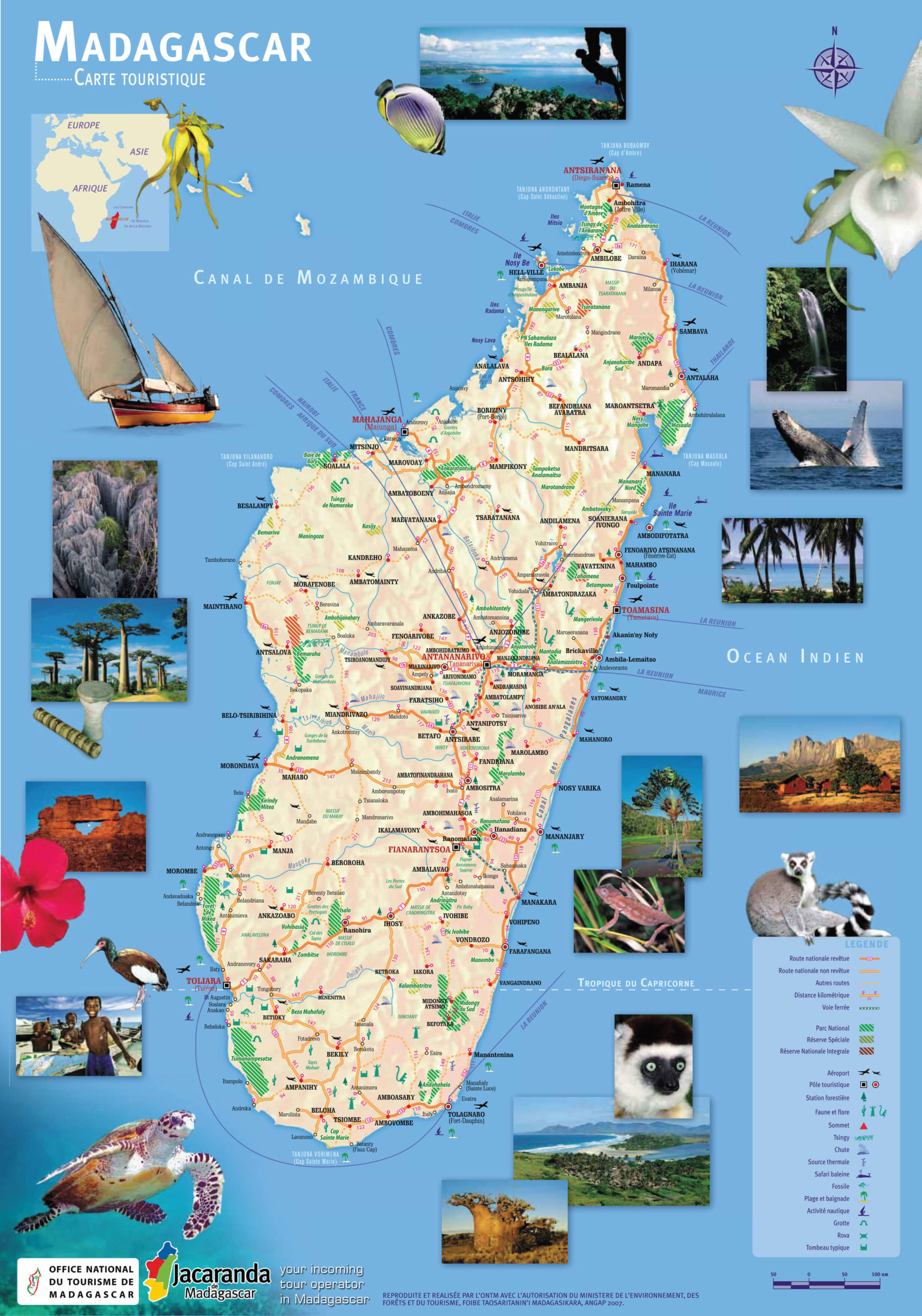
Good to know
FAST FACTS
Population: 17,308,000
Capital: Antananarivo; 1,678,000
Area: 587,041 square kilometers (226,658 square miles)
Language: French, Malagasy
Religion: Christian, Indigenous beliefs, Muslim
Currency: Malagasy Ariary
Time difference: GMT +3 during winter time, GMT +2 during summer time.
Electricity : 220 V, European standard
Country phone code : +261
MUST-SEE
HIGHLIGHTS

Baobabs
The baobabs of Madagascar have to be seen to be believed. It is a majestic and sacred tree that counts eight species. Six of them only grow in Madagascar. They are in abundance in the southern and western regions. The largest one, Adansonia grandidieri, lines the Avenue of the Baobabs on Madagascar’s west coast.


Nosy Be archipelago
Nosy Be is the largest island of the archipelago of the same name, located off the northwest coast of Madagascar. The archipelago is considered to have some of the most beautiful beaches in the world and is also a world-famous diving spot. It is also called the “perfumed island” because of the strong smell of ylang-ylang flower all around the island.

Lemurs
Lemurs are a monkey species endemic to Madagascar. You can only find the five families of this atypical monkey on the “Great Island.” They can be found in National Parks, natural reserves; or in their simplest habitat, the rainforest. Malagasy fauna will give a little magic to your excursions during a forest hike, your outings in the Great South; or your birdwatching tours.


Isalo National Park
Isalo National Park is one of Madagascar’s most visited natural parks and is located in the country’s southwest. The park itself is made up of a savannah and desert landscape with huge canyons and hidden oases. Stunning panoramic views and some of Madagascar’s most iconic wildlife, the lemur.


The Tsingy
Made by erosion, the Tsingy of Madagascar are fossilized shells’ formations. Admire them into fantastic landscapes, the immensity of the Tsingy remember us a forgotten era : the Jurassic. Its name, ‘Tsingy’, translates as ‘where one cannot walk barefoot,’ which is apt due to its pointed rock pinnacles.

Andasibe National Park
This tropical rainforest is known to shelter the biggest lemur of the world: the indri. It is very common to see a 31 inch tall indri come observe you from the top of a tree. If you take a morning hike, you will hear the singing of the indris through the forest, which will surely delight all visitors.


Beaches of Ifaty region
Located on the southwest coast and offering beautiful beaches with a fabulous sub-tropical climate, this region is also a traditional fishery zone. An amazing opportunity to see the scenes of daily life of marine Malagasies. Enjoy diving on the world’s third largest coral reef. Further to the north, even more authentic and traditional fisherman’s villages await you with amazing deserted beaches.

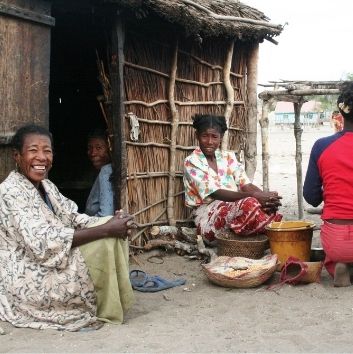
Culture and traditions
The culture and traditions of Madagascar are just as distinctive as its rightly famous flora and fauna. Madagascan culture is a curious and colourful fusion of Asian, African, and Arabic culture. There are 18 ethnic groups, each with their own traditions and beliefs, based on a close and mysterious connection with nature, death and the God’s world.

Palmarium
Also known as Ankanin’ny Nofy (‘nest of dreams’) this region is spread across a peninsula land on the East coast of Madagascar, nestled on the banks of the Pangalanes channel and the Indian Ocean. It is one of the most beautiful areas along the Pangalanes Channel where fishermen float by and go about their peaceful daily lives. You can spot several lemur species, and it is one of the rare places to spot the endangered aye-aye lemur.


Ranomafana National Park
Ranomafana, is a natural rainy forest park classified among the World Natural Heritage since 2007. It serve as a shelter of a great richness of endemic but endangered biodiversity including several lemur species. It is traversed by many streams which are tributaries of the Namorona river.


Whales
Every year from June to September, the humpback whales migrate off the northeast coasts of Madagascar to mate and give birth. You will be able to go on board in small groups to observe these impressive marine mammals arriving by hundreds. Do not miss the whale-watching tour to observe the majestic ballet of humpback whales.

Sainte Marie island
A paradise island in the heart of the Indian Ocean, Sainte Marie is an authentic place that is preserved from mass tourism. It is a real haven of peace in an idyllic setting made up of beautiful beaches and fishing villages. It is a former pirate’s hideaway with lush vegetation and maybe the best point to spot humpback whales during the mating season.


Rice fields of the Highlands
The landscapes of the Highlands with their multicolored rice paddies and villages echant all visitors. We see peaceful sceneries of typical villages among paddy fields and hilly landscapes, of the farmer’s daily, traditional work routine. The panorama of the rice fields around Betafo were nominated to the UNESCO World Heritage List of Landscapes. .


Kirindy Reserve
Kirindy reserve is a true wildlife oasis. This dry deciduous forest is one of Madagascar’s truly outstanding natural areas – a fauna and flora hotspot. It is particularly famous for two things: the fossa and the lemurs – especially the nocturnal ones. This is one of the few places on the Island where you can see the shy Fossa – the top predator of Madagascar, quite easily.

Ambohimanga Royal Hill
Being classified as UNESCO World Heritage, the royal hill of Ambohimanga consists of a royal city, a royal funerary site and a set of sacred places. Associated with a strong sense of national identity, it retains its atmosphere of spirituality and sacredness, in practice and in the minds of the population, for some 500 years.

OVERVIEW
MADAGASCAR, ISLAND OF A THOUSAND FACES
You have a wide range of variety of landscapes and climate zones in Madagascar. Here you can read a brief explanation of the geographic situation of land and sea, followed by more detailed information about the main regions of our country-island. Be prepared that as the island is very big (nearly the size of France), you can visit one region during a 6-10 day long tour. It is possible of course to do tours combining different regions by adding extra days to your trip.
- THE LAND
Madagascar boasts 5,000 kilometers of coast, is 592,000 km² large, and its highest peak is Mount Maromokotra located 392 kilometers off East Africa’s coast. The geography of the island is relatively simple. From North to South, high reliefs and a series of lake basins run through the center. Erosion is variably important, having created spectacular sites such as Isalo.
The coast is rather different from one side to the other. In the East, it is narrow, due to the fact it is trapped between the edge of the Central Lands, sometimes referred to as “cliffs”, and the ocean. In the West and the South, reliefs progressively decrease in slope to the level of a wide plain, which is often interrupted by large majestic rivers. Madagascar, the “small continent” is surrounded by a multiplicity of islets, some of which are grouped in archipelagos.
- THE SEA
Madagascar’s seashore is approximately 5,000 kilometers long. The most popular sea is located in the North West. Its creeks, harbors and islets make it ideal and popular for leisure boating. From Majunga to Tuléar, the mild-sloped coast has mostly remained in its wild state, and traditional dhows elegantly sail along it. The arch formed by the Southern coast before joining the Indian Ocean can literally be described as the end of the world, given the fact that only Antarctica can be found beyond; it is decorated with isolated fishermen’s villages, pristine sand dunes, waves meeting surfers’ expectations. From Fort Dauphin onwards, the coast takes a strangely straight shape, up to Baie d’Antongil’s indentation. Underwater, Madagascar’s well-located coral reefs are among the world’s most beautiful diving sites.
unique nature
Madagascar, a biodiversity hotspot
Madagascar’s leading tourist product is nature, 80% of the wildlife and 90% of its plants being endemic. We can choose birdwatching to illustrate the excitement it can generate, as minority niche tourism for very specialized enthusiasts. Birdwatchers may travel long distances but they know what they want, and will find it in Madagascar. They observe, take photos, list, record and are not bothered about going out into the forest at night. When the passion for nature has you in its grip!
Sadly, much of Madagascar has been destroyed, by the gradual action of small farmers, herdsmen, industrial businesses and climate change. As the forest is destroyed, so is the habitat for Madagascar’s unique plant and animal species. The loss of habitat due to deforestation is the biggest single threat to Madagascar’s wildlife. A threat which is calculated not in tens of millions of years, but in generations at risk, resulting from man’s unconsciously suicidal pressure on his own environment.
Sustainable tourism is more than a passing fad and is taking action against such destruction, thanks to ethics that unite visitors and their hosts. In Madagascar it is now very present, better understood, and centres for it are springing up all over the regions.
wildlife
This is characterized by very high levels of endemic species and no big cats. Apart from lizards and some varieties of scorpions and centipedes, there are virtually no species dangerous to man.

Mammals
The puma-like fosa is the largest carnivore in Madagascar. 5 species of mongoose are endemic, including the Amber Mountain ring-tailed one. The Tenrecs, resembling hedgehogs, are very prolific with litters of up to 32 young. As for bats, they have diversified into 28 species.
The gems of the island’s wildlife, lemurs, have large eyes for easy night vision and thick, sometimes woolly, coats. The smallest lemurs are no bigger than your thumb while the Indri is the size of a small boy. The ring-tailed lemur is familiar to tourists thanks to its upright posture and friendly nature. For its part, the aye aye, saved from extinction in the sixties, remains a mystery to science. The discovery of new species is far from being over.

Fish & turtles
92% of freshwater fish species are endemic. Coral reefs are home to a multitude of fish of all shapes and colours, as well as remarkable species such as manta rays. At certain times the largest fish in the world, the whale shark, may be found in the waters of Nosy Be, and, if luck is on your side, the oldest one, which is the coelacanth. You can quite easily observe sea turtles around some of the beaches of the island.
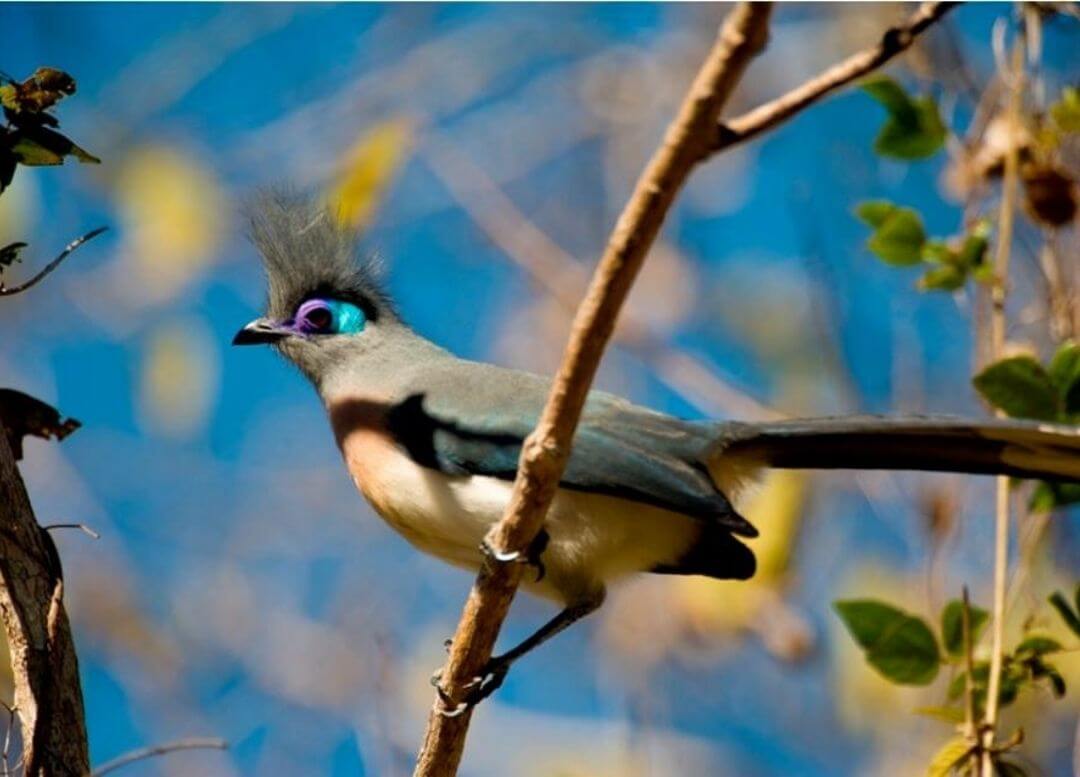
Birds
Madagascar has a relatively small number of bird species (285). But 110 of them are endemic and this tally is rare elsewhere in the world.
The endemic bird species include five families of birds found only here and on the nearby Comoros: the mesites, the monotypic Cuckoo-Roller, the ground-rollers, the asities, and the recently separated Malagasy Warblers (Bernieridae). Additionally, the couas comprise a distinctive endemic subfamily. It is also sadly a place where habitat destruction and over-population greatly threaten biodiversity, so it’s an important destination on any birder’s must-visit list.

Reptiles & amphibians
Chameleons could symbolize Madagascar just as well as lemurs. Two thirds of the world’s species live on the Great Island, from the smallest (Chamaeleo Nasatus 10 cm) to the largest (Chamaeleo oustaleti 70 cm). A protected species, the Nile crocodile is concentrated in certain areas with large rivers. Feared or revered, these lizards sometimes have a special place in popular beliefs which equate them with the ancestors.
Tortoises, including the radiated tortoise and the ploughshare tortoise, are endangered species subject to trafficking. Several species of sea turtles are found among the coral reefs, laying their eggs on deserted beaches.
Frogs are among the most colourful creatures on the island, dancing multi-coloured ballets on wetland vegetation. More than 150 species have been recorded, and others are still being identified.

Invertebrates
Madagascar has a relatively small number of bird species (285). But 110 of them are endemic and this tally is rare elsewhere in the world.
The endemic bird species include five families of birds found only here and on the nearby Comoros: the mesites, the monotypic Cuckoo-Roller, the ground-rollers, the asities, and the recently separated Malagasy Warblers (Bernieridae). Additionally, the couas comprise a distinctive endemic subfamily. It is also sadly a place where habitat destruction and over-population greatly threaten biodiversity, so it’s an important destination on any birder’s must-visit list.

Whalewatching
From July to September, humpback whales come to calve and mate in Malagasy waters after swimming over 5000km from the Antarctic. Whale-watching is governed by strict behaviour standards, so as not to put the whales under stress and ensure tourists’ safety.
You can go to whale-watching tours at several places of the island (Nosy Be, Ifaty, Anakao, Antongil-Bay). The most popular spot is the island of Sainte Marie and in particular the Channel, where the newborn baby whales can thrive at ease beside their mothers. Not to be separated under any circumstances! The dancing display of these ocean giants leaping out of the water may be admired from a boat, or sometimes even on dry land.
plants
In the plant kingdom Madagascar has experienced explosive species diversification due to the wide variety of ecological zones and partitioned areas.
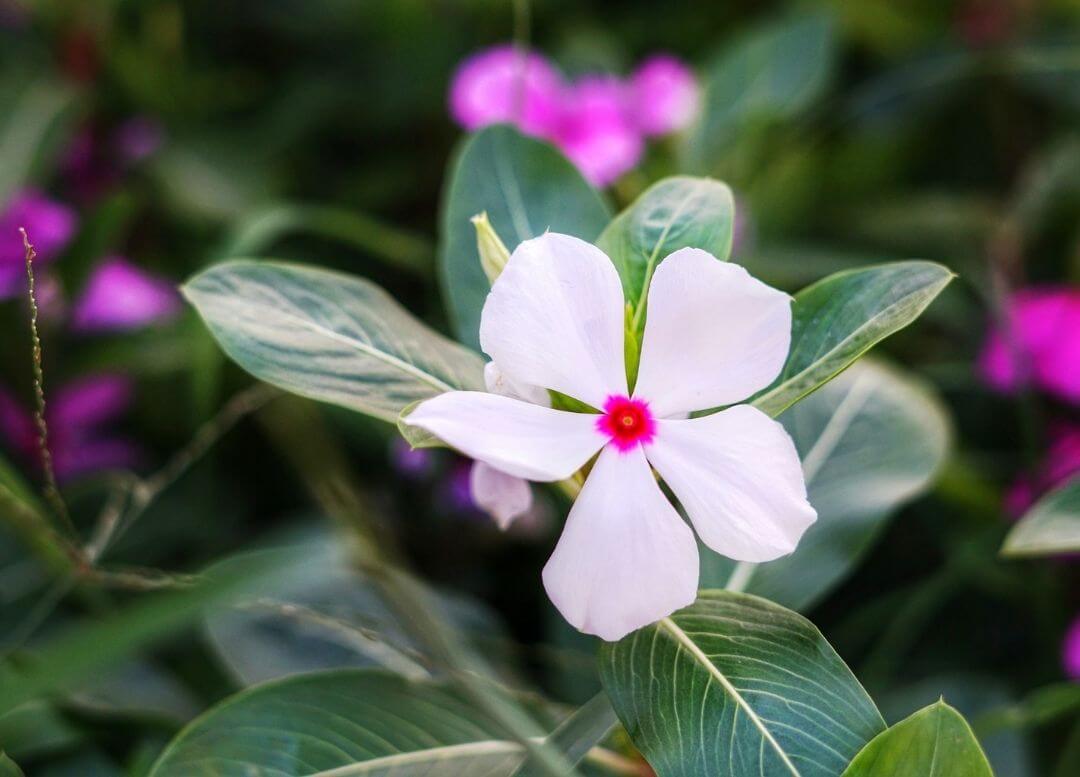
The Centre
They are less well-endowed, but rocky slabs and granite domes can have beautiful plants with graceful flowers such as in Angavokely, east of Antananarivo.
The ledges to the west and south are particularly rich in xeric flora adapted to difficult conditions by a water accumulation system. The stone-plant for example, is very common in the Itremo mountains west of Ambositra or Ibity in the Antsirabe region, with its flowers springing out of the ground.

The West
This is the realm of savanna and baobabs, of which Madagascar has 7 species as opposed to two for Australia and one for the whole of Africa. The plants here have rather unusual features: Euphorbia stone pine, vines whose stems appear only in the rainy season, pachypodium shaped like a long-necked bottle, and a beautiful fern out of place in these frequently drought-stricken places: the Platycerium Quadridichitimum.

The East
The eastern forest supplies man with food, medicines, clothing, building materials, tools, ornaments … 90% of its species are thought to be endemic. It is the favourite environment of valuable tree species that often arouse much envy, and orchids in various sizes and colours such as Aeranthes whose flowers grow to 60cm, or Cymbidiella Rhodichila with clusters of yellow flowers stained with green spots. But the tree best symbolizing the east of the island is the Traveller’s Tree or Ravinala with its fan-shaped leaves and store of reputedly cool water. Take that with a pinch of salt!

The South
The Bush is an exceptional natural environment due to low-growing vegetation and thorny scrublands adapted to less than 500 mm of annual rainfall. The Didieraceae do not go unnoticed there, from the wild branches of the Alluaudia Humberti to the tentacles of the Octopus Tree. The Kalanchoe can apply for the Originality Prize with the three-cornered leaves of the Beharensis. In the Aloe family (38 species), the Vaombe Aloe is perhaps the most beautiful plant in Madagascar. Growing over 6 meters tall, it can carry up to one hundred clusters of bright red flowers.

Mangroves
These are strange environments of amphibious forests whose most famous tree, the Mangrove is perched on stilt roots. Its cousin, the Red Mangrove, has roots sticking out of the water like snorkels. One of Mother Nature’s jokes!! Some locations: Ambondrolava 12 km north of Tulear, Antsahampano and Ambohidravy Forest Reserve in the Ambanja region, the east coast of Ste Marie, and the north and east coasts of Nosy Be.
CULTURE & TRADITIONS
immersion in a different world
Long before the people of the North discovered the Indian Ocean and the Southern Pacific, important migration fluxes had already taken place there; several of them included Madagascar as a stop-over or a destination. In the context of the evolving melting pot resulting from migration, social groups took the habit of defining themselves in relation to their environment. Thus, the Sakalava for instance define themselves as “The-people-of-the-small-valley-that-cuts-through-the-big-one”, the Tanala “People-of-the-forest” or the Merina “People-of-the-Highlands” ; the Antandroy are the “The-people-living-in-thorns” and the Antemoro “Men-of-the-shores”.
Nowadays, the population counts a little less than 20 million inhabitants, split between 18 ethnic groups and a multiplicity of social sub-groups.
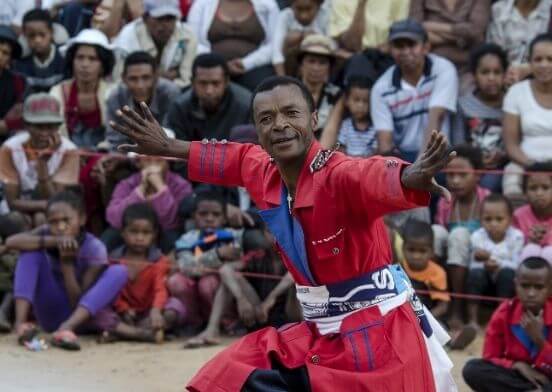
Celebrations & rituals
All regions in Madagascar have their mutiplicity of colorful rituals, during which the present merges with the past. In Antananarivo, several noble castes continue to celebrate the Malagasy New Year or Alahamady and attempt to revive its past prestige. A more deeply rooted celebrated ritual is the Tsanga-tsainy, organised every 5 years by the Antakarana in the North. The national flag of the Republic is elevated along with the royal crescent-and-red-star flag.
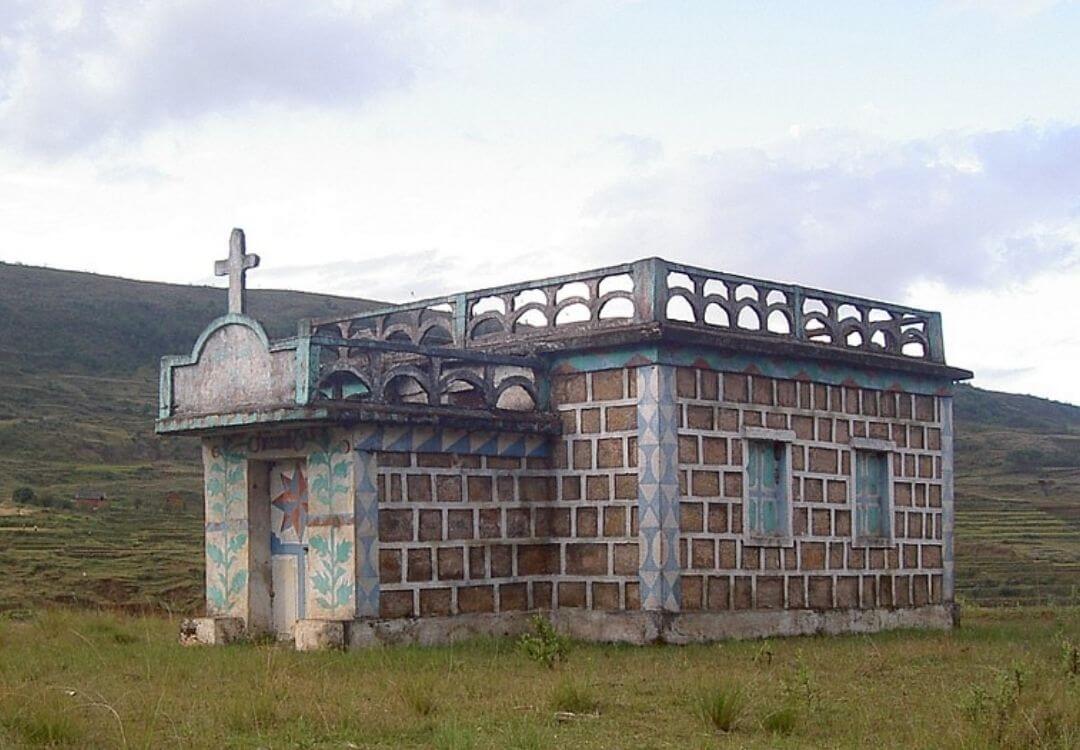
Ancestors
Madagascar is renowned as the country of Ancestors’ Cult. In the traditional belief, ancestors or Razana are considered potent forces who increasingly acquire power, due to the fact that they are close to the Creator or Zanahary.
In some regions of the South, tombs are real mausoleums painted with bright colors, and where sadness is nowhere on the agenda. Funerary stelae are lively and realistic pieces of art. One can communicate with royal ancestors! Their responses are transmitted via an intermediary called Saha in the North, during a ritual trance-like state called Tromba. The ritual takes place in a raunchy atmosphere where good music, food and rum are all available to one’s content.

Rice
In Madagascar, visitors are advised to respect children, mothers, the elderly and rice fields. A Malagasy will not invite you for “lunch“, but literaly to “share his/her rice”.
Rice is ever-present in some of the traditional proverbs, which so elegantly illustrate the Malagasy language:
- You balk at working hard, yet you want good quality early harvested rice!
- Love is like a young plant of rice: transplanted, it grows somewhere else.
- Do not sing your own praises like the boiling rice in its pan!
- Sorrow is like rice in a granary: its quantity decreases everyday.
- Behave as an ear of rice: standing straight is good, knowing how to bow is better.
And many more … BON APPETIT !!!
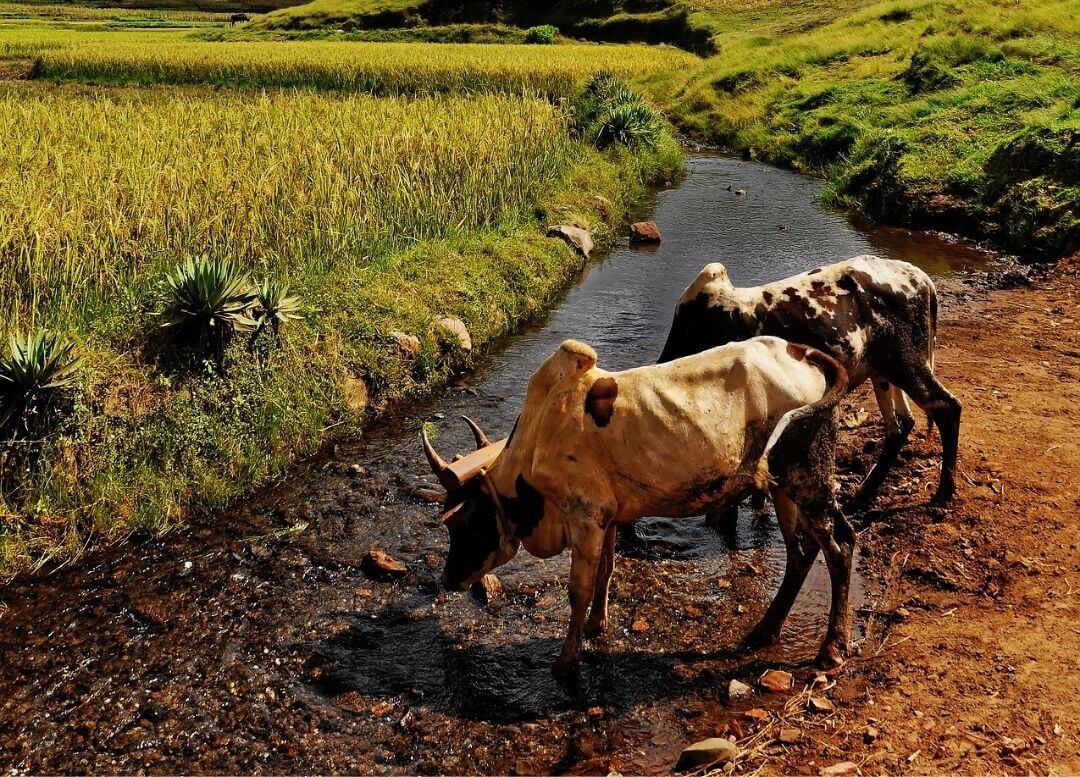
Zebu
Madagascar has two equally-important symbols: the wild-with-freedom-lemur and the “ox with a hump” or zebu. Indicative of wealth, the latter defines social ranking. In the South, a deceased man’s local importance is indicated by the number of zebu skulls displayed on his grave. Should any social event or clan reconciliation be considered, they would not occur without a joro, the sacrifice of one or several carefully-selected zebus. Each individual will receive a share of the meat, so as to consolidate the Fihavanana: solidarity and harmony.
Nothing goes to waste in a zebu: its quiet strength for the yokes and labour; its dung to be used as fertiliser and a few rural traditional uses ; its leather for handicraft; its horns for the preparation of ranomena, a potion, which despite its foul smell is believed to have several virtues; the meat is simply exquisite for cooking.
SSSHHH…
Our secret tips
Sundowner at Lokanga, Antananarivo
Located in an idyllic setting in the heights of Antananarivo, the restaurant is offering an attentive welcome, careful service and quality dishes. On sundowners, dishes are served on the terrace overlooking a dazzling view of the capital. A privileged moment that will make you appreciate the best of Antananarivo.
Zebu market in Ambalavao
The big zebu market takes place every Wednesday and Saturday, in a setting that would certainly fit in a Wild West movie. Thousands of cattle and people gather for the big event, some from several hundred miles away. Bidding and shouting are made amid hundreds of head of cattle, after which the cows and bulls change hands.
Hidden villages of the rice fields
This walking tour is an incredible experience to meet local people off the beaten track. We walk among the rice fields on narrow paths used only by locals, to reach some hidden villages only accessible by foot. During the way, we interact with local peasants working on the fields,
Pere Pedro's Sunday Mess
There is an incredible person living in Madagascar, doing incredible work against poverty: the lazarist missionary of Argentinean and Slovenian origin, Father Pedro Opeka. He has been nominated for the Nobel Peace Prize for his work among the poor in Madagascar since 1976.
Among other projects, Pedro created the Akamasoa quarter in Antananarivo, literally constructing a town on a rubbish dump and making it a sanctuary for more than 25,000 people. Its small pastel houses seem drawn from a fairy tale. This is where his popular Sunday Masses are held, in the stadium of the district, and no one can remain uninspired by the thousands of people and children singing and dancing with incredible enthusiasm.
When you see Father Pedro you are impressed by his energy, his sense of justice and his great spirit.
Visit of the sappphire mines in Ilakaka
A unique chance that no one can miss out.
The world’s biggest sapphire open pit deposit is located along the unique tarmac road aiming to the south: the “Malagasy Route 66”, the famous National Road N° 7. The region of Ilakaka is a 4’000km2 large mining area and there are over 30.000 people living in town. You can safely reach and discover the sapphire mines, a curious and unknown experience and exciting adventure.
Having a „Far-West” athmosphere, miners acquire an “almost acceptable” remuneration that allows them to live decently but their dream about “ the gem piece that will change my life” remains a powerful motivation factor.
Travel like the locals - zebu-cart, pirogue or pousse-pousse
If you feel like emerging in the local lifestyle, we definitely recommend trying one (or more) of the traditional Malagasy ways of transportation. Because of the poverty and lack of good transportation infrastructure, these ancient and eco-friendly means of transports are still used by locals everywhere in the country.
Engineless pirogues or lakanas (dugout canoes), whether on rivers or the sea, are frequently used in areas with no road network. It is an unforgettable experience to sail with these traditional fisherman’s boat built only and exclusively from wood. In rural areas of the country, the charette (a wooden cart drawn by a pair of zebu cattle) is the most common form of transport. In cities, people travel by pousse-pousses – which are rickshaws made of colourfully painted wood, either pulled by a man on foot or on a bicycle (Cyclo-Pousse).
REGIONS
A variety of landscapes & climate zones

We at Jacaranda give a color to each region,
the color representing the athmosphere, the climate and the landscapes of the regions:
green for the forests of eastern Madagascar;
red for the vast expanses of the west,
blue for the beauty of the coastline to the north,
yellow for the thorny semi-desert to the south.
“YELLOW”
THE GREAT SOUTH
For the driver following the National Highway 7, the Deep South starts at Ihosy, where the road enters the land of the proud Bara herders and their cattle. The climate and the soil become drier. Indeed, a mountain range prevents the trade wind and its rain from entering the South. We find here the land of the Mahafaly tribes who are famous for their magnificent funerary art. They build their tombs as permanent structures; their houses, on the other hand, are made of wood. In the Tuléar region, the purity of the atmosphere is characterised by some of the most beautiful starry nights in the world. The Deep South is a strange universe, crossed by the Tropic of Capricorn, where nature seems to confuse ungratefulness and extravagance. What nature has to offer here is unlikely to be found anywhere else.
The beaches to the north and to the south of Tulear are characterised by endless white sand dunes. Here is the heart of the coral reef of the South West. Inside it, the fabulous landscape characterized by corals, sea anemone, and sponges reveals itself according to the tides. On the inland part of the beaches the famous, unique and strictly protected “spiny dry forests” shelter a very wealthy endemic biodiversity.
When to visit:
all-year long
Climate
Dry, semi-desert
Highlights
Isalo NP, Berenty NP, Anja reserve, baobab trees, spiny dry forest, mahafaly tombs, beaches of Ifaty, coral reef
Seaside
Ifaty, Anakao, Salary
“GREEN”
THE LUSH EAST
In the Malagasy people’s perception, the Eastern forest symbolises inexhaustible wealth! Such a positive image should be toned down as deforestation also remains an issue to tackle in this part of the country. The East has tremendous potential, thanks to the valuables tree species of its forests, its underground resources, its abundant food and industrial production, its natural sanctuaries and preserved sites. The famous “Eastern rain” does not even constitute an impediment to visitors. Nature would not be this beautiful without it…
The South East of Madagascar is more difficult to approach; it hide sites, which are barely acquainted with tourism, but which amaze their visitors. With the forests in the background, the Betsileo, Tanala and Antemoro landscapes will reveal themselves to the eyes. Both the North and South East are lands of great diversity.
When to visit:
from April to November
Climate
Tropical humid
Highlights
Andasibe-Mantadia NP, Palmarium Reserve, Pangalanes Channel, lush rainforests, Sainte Marie Island
Seaside
Sainte Marie Island, Foulpointe
“BLUE”
THE ENCHANTING NORTH
The North West, from Diégo Suarez to Baie de Baly accounts for the most beautiful sites in Madagascar. Pristine beaches, creeks, and rocky shores stand along an islets-dotted sea. The hinterland, combining a magnificent marine environment with a remarkably interesting coastal one, symbolises the uniqueness of the Big Island.
Located off the northwest coast of Madagascar, Nosy Be is the largest island of the archipelago of the same name. The archipelago is considered to have some of the most beautiful beaches in the world. The exotic island is the location of a lot of luxury hotels, gourmet restaurants, nightclubs and shops – but it has maintained the most important: the natural harmony and the quiet atmosphere. The rare black lemurs and the chameleon live on its territory. World-famous diving spots await the divers on Nosy Be Island. In addition to hundreds of exotic sea-dwellers, one can see the ruined old ships in coastal waters.
The Antongil Bay and the SAVA regions are biodiversity-rich with a lot of their history written by pirates. It is also believed that it was one of the very first places of human settlements in Madagascar. Could this be the reason why in each Malagasy house the North Eastern corner is considered the ancestors’ corner?
When to visit:
from March to December
Climate
Hot and humid
Highlights
Amber Mountain NP, Ankarana “Tsingy” NP, Lokobe NP, vanilla and ylang-ylang fields, Nosy Be islands
Seaside
Nosy Be islands, Diego Suarez
“RED”
THE MAJESTIC WEST
Infinite rice fields, granite hills, picturesque villages; then the descent towards the west coast through a succession of landscapes that vary from kilometer to kilometer. Then the majestuous baobabs… And the apogee is the incredible extraordinary geomorphology of the Tsingy de Bemaraha, a World Heritage Site. But here is not the end; golden beach and fantastic wildlife are still awaiting you ahead.
This area has three components, each with a strong “personality”: the Menabe Region, the land of baobabs, of which Madagascar boasts 7 varieties. The majestic Manambolo and Tsiribihina Rivers, which are more than just pretty . The experience of sailing on them remains equally engraved in cameras and memories; Lastly, the Bemaraha Tsingy in the neighbouring Melaky region, were extracted from the sea million years ago and will be erased by the same erosion that created them, in a few million years to come. The Malagasy West is a huge area to be protected…
When to visit:
from April to November
(Bemaraha tsingy: July-November)
Climate
Hot and dry
Highlights
Baobab Avenue, Bemaraha “Tsingy” NP (UNESCO), Kirindy-Mitea NP, Tsiribihina River
Seaside
Morondava, Belo sur Mer
THE CENTRAL HIGHLANDS
The center of Madagascar, with the diversity of its landscapes is like a stronghold of the island. The wide rocky landscapes where people only seem to be intruders sharply contrast with densely-populated areas, bodies of water, and rural areas with their rice paddies’ checker the landscape. Land of traditions, rich with historical places, it exhibits a continental trait and is careless of the fact that one short plane trip can take you to coast of Madagascar!
Drive through beautiful and peaceful countryside and immense rice fields, visit ancient tombs, admire the craftworks of local artists, take village treks to immerse in local life and visit emerald volcanic lakes.
The Central Highlands of Madagascar stretch from North to South along more than 1000 kilometres of the central part of the island. The altitude varies from 800 to 2700 metres at the highest peaks, but the main area lies slightly over 1000 metres above sea level. You can find the oldest and most historical cities of Madagascar in this region. The landscape is made up of a varied plateau with hills and several higher mountains, valleys and rivers, the biggest lakes of Madagascar, shimmering rice fields and hollow-like depressions. The lush rainforests and rich wildlife of Ranomafana National Park (UNESCO) are just a short ride from the town of Fianarantsoa, the center of the Betsileo tribe.
When to visit:
all-year long
Climate
Temperate
Highlights
Antananarivo, the capital, Ambohimanga Royal Hill (UNESCO), Antsirabe city, Fianarantsoa city, Ranomafana NP (UNESCO), funerary art, beautiful landscapes, zafimaniry wood carving (UNESCO)
Seaside
none
ISLANDS OF NOSY BE
Nosy Be is the largest island of the archipelago of the same name, located off the northwest coast of Madagascar. The archipelago is considered to have some of the most beautiful beaches in the world. The exotic island is the location of a lot of luxury hotels, gourmet restaurants, nightclubs and shops. For many years now the world famous celebrities Nosy Be have chosen for the rest. Despite the rapid development of travel and entertainment infrastructure, the exotic island has maintained the most important – the natural harmony and the quiet atmosphere. The rare black lemurs and the chameleon live on its territory. A pleasant surprise awaits the divers on Nosy Be Island. In addition to hundreds of exotic sea dwellers, one can see the ruined old ships in coastal waters..
The various scents of Nosy Be welcome visitors upon their arrival at the Facène Airport: ylang-ylang, spices, sugar cane, coffee and vanilla. Hence the nickname of the island: “the perfumed island”. The landscape is diversified and dominated by the Lokobe Mount (450 m) and the Passot Mount (315m); the view of magnificent sunsets from those two viewpoints are legendary. You can observe the endemic vegetation and wildlife of this region in the Lokobe National Park. In the course of a hike passing villages, sugar cane fields, ylang-ylang plantations or old secular mango trees, one can visit distilleries which offer sampling of their produce. In addition to its vegetation and plantations, Nosy Be boasts magnificent beaches, such as those of Ambatoloaka, Madirokely or Andilana, to name only a few.
When to visit:
all-year long
Climate
Tropical
Highlights
the islands of Nosy Be archipelago, Lokobe National Park, beaches of Nosy Be, diving
Seaside
all around
PRACTICAL INFORMATION
Frequently asked questions
Travel prepared – we will share with you all important information to know before the trip. Do I need a visa? How is the climate? Are there any obligatory vaccinations? Etc.
CLIMATE
There are two seasons in Madagascar : the dry season or southern winter lasts from April to October, and the wet summer season from November to March. However, the climate is very different in each region of the island.
visa
You can easily obtain a tourist visa for a fee at the airport upon your arrival or at the Consulate of Madagascar in your country. Your passport must be valid for a minimum period of 6 months from the date of entry into Madagascar.

health
No vaccination is compulsory for travelers coming to Madagascar, except if they have been on transit in an infected zone. Anti-malaria prophylaxis and one injection of gamma globulin against hepatitis A are recommended.
What to bring
Light clothes are recommended all year long, during winter time you should pack some warmer clothes especially in the Highlands. Light trekking shoes are advised for national parks. Take your own medical kit, disinfectant, mosquito repellent, malaria medicine, sunscreen.
By getting angry,
one shows that he is wrong.
malagasy saying

